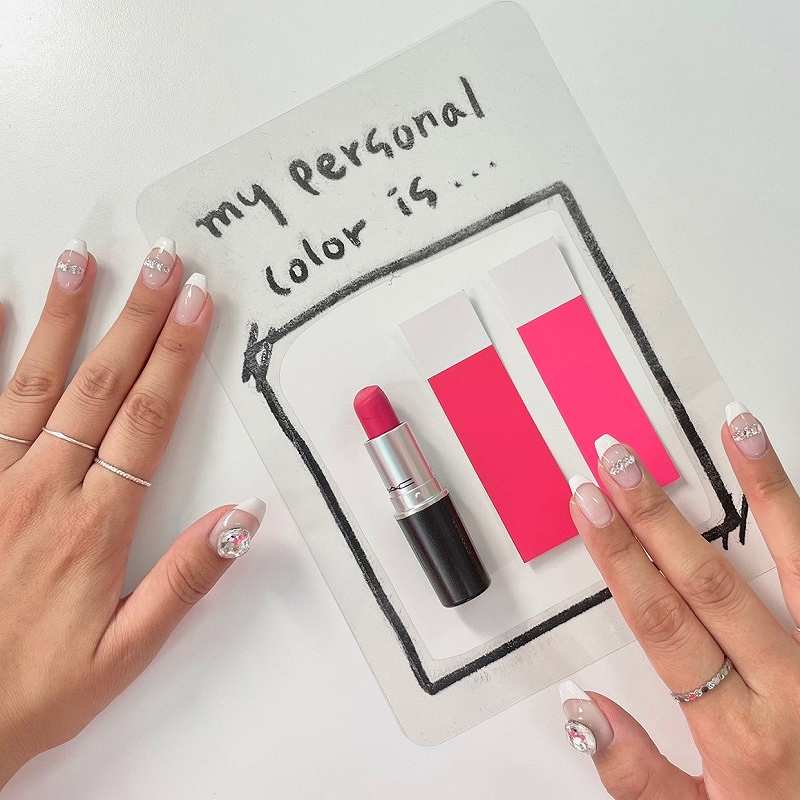
A lipstick and woman’s hands are seen.
13:00 JST, December 24, 2022
Are you warm-toned or cool-toned?
The current craze for South Koreans is to take personal color tests — or consultations that provide recommendations for people’s personal color types.
The tests, largely held offline for accuracy, have professional analysts evaluate whether people fall under the category of “warm-tone” or “cool-tone,” by scrutinizing their skin tone.
According to the tests, warm-toned people generally have a yellow-base skin undertone, while cool-toned people harbor a blue-base skin undertone.
The South Korean personal color system breaks it down further into four color types: spring warm, summer cool, autumn warm and winter cool.
Spring warm-toned people are generally suited for yellow undertone colors that are light and pastel-toned, while autumn warm-toned people are best styled with deep and darker yellow undertone colors.
Meanwhile, summer cool-toned people are to be styled with color palettes that include cooling, soft and bright colors — whereas deeper, striking colors with blue undertones like forest green, wine red and black are recommended for winter cool-toned people.
Personal color types are determined for an individual after they go through consultation sessions such as draping and pouch analysis.
During the draping portion of the testing sessions, fabrics of multiple colors are draped across the shoulders of the customer to see the effect of each color on a person’s general style.
The drapings discern the colors best suited for each customer and work as the evaluation tool for analysts to determine each person’s personal color type.
Next, customers’ makeup pouches are analyzed, and the analysts look through the makeup items most often used by the customer to advise them on the type of cosmetics they should or should not use.
Diagnosis reports which elaborate in detail about the person’s general style are finally given to each customer after the session is over.
So, where did these personal color tests come from?
The basic theory for warm and cool-tone differentiation stems from American artist Robert Dorr’s color key system theory, which underscored that colors were most harmoniously used when using the same undertone of either blue or yellow.
Fashion designer Suzanne Caygill applied Dorr’s system to people’s physical traits, determining a person’s personal color after examining individual’s color of skin, hair and pupil.
Expanding on Caygill’s idea, color consultant Carole Jackson classified human images by the four seasons in her bestseller “Color me beautiful” — which became the origin of inspiration for multinational beauty consulting companies in the United States and Europe, to commercialize the process of personal color diagnosis for international consumers.
The tests entered the South Korean market for the first time in 1993 and gradually became a hit.
Continuing the momentum of its popularity, a slew of South Korean beauty companies have too released personal color system-related goods as a part of marketing tactics.
South Korea’s first personal color-related goods started with Espoir, a cosmetic brand under the nation’s beauty and cosmetics conglomerate Amorepacific.
Named Real Eye Handy Palette, the eyeshadow palettes composed of selections of color centered around each personal color season.
Releases of series of goods and services followed, such as AI-based personal color analysis applications and personalized cosmetics that analyze a person’s skin tone prior to developing the product.
For one, Amorepacific’s cosmetic manufacturing technology “Tonework” customizes makeup products based on colors most suited for consumers. It measures the color of a person’s face using AI algorithms and has robots manufacture customized liquid foundations, cushion compacts and lip products based on a person’s personal color type.
The most popular Snapchat-like camera app in South Korea, Snow, operated by Naver, also offers diverse personal color type filters for its consumers to use.
Then why did these personal color tests become such a hit?
Experts pinpointed an increased interest in self as one of the factors.
“Before, people were eager to follow what the celebrities had on as part of their makeup,” said Yoon Jung-ha, CEO of Zamface, an AI-based app that allows users to take the personal color tests on their own. The virtual personal color test-dedicated app recorded 1.7 million users as of December.
“People used famous makeup products whether or not it suited themselves, but now more focus is being spent on whether the makeup products suit their own style,” she added.
The comfort of belonging to a certain group had also contributed to its popularity.
“People tend to seek for a certain sense of belonging during uncertain times. Personal color system, in that aspect, could have provided people with a category in which to fit,” said Lee Young-ae, a professor of consumer science at Incheon University.
She cited South Koreans’ affinity for MBTI (Myers-Briggs Type Indicator) personality tests and the tests which categorized individuals based on blood type, noting that people like to be “classified” into certain groups.
She further mentioned that with increased online shopping, people needed to be certain if the color of the makeup products would suit themselves without trying them out in person, saying that a personal color system provided consumers with a standard upon which to fall back on.
However, the results of the personal color system should not be trusted blindly, experts also added.
“The personal color system itself is based on a sound scientific theory,” said Shin Hyang-seon, the president of Korea Color Industry Specialist Association.
She said people’s skin undertones, which are determined by three elements including hemoglobin, carotene and melanin, are defined by genetics and will never change, emphasizing that, in that matter, there will always be colors best suited for an individual from the moment they are born.
“However, skin overtones can change based upon factors such as sun exposure, the type of food a person eats, and natural aging — leading to a more difficult assessment of a personal color system as a person ages,” she added.
Moreover, she stressed that the current personal color system market is filled with analysts who are not qualified enough to be giving out recommendations.
“The personal colors are best diagnosed by colorists [specialists in color]. But people of different occupations such as makeup specialists and stylists are currently giving out personal color tests, which could lead to a potentially inaccurate diagnosis of personal color types,” said Shin.
Moreover, with the test initially designed for foreigners, for higher accuracy, a separate uniform system for personal color needs to be established specifically for Asians, Shin added.
“South Koreans have taken the personal color type theory and tests possibly the furthest out of all the countries in the world. The tests could become a foundation stone for the growth of the nation’s beauty market,” Shin said.
"World" POPULAR ARTICLE
-

8 Japanese Nationals Stranded on Indonesia’s Sumatra Island
-

Mozambican Cooking Class Held in Matsuyama, Ehime Pref.; Participants Don Aprons, Bandanas Made from Traditional Mozambique Fabric
-

China to Impose Sanctions on Shigeru Iwasaki, Former Head of Japan’s Self-Defense Forces, Who Serves as Adviser to Taiwan’s Executive Branch
-

China Steps Up ‘Wolf Warrior’ Diplomacy Against Japan, Hurling Accusation About Plutonium Stockpile
-

U.S. Senate Resolution Backs Japan, Condemns China’s Pressure
JN ACCESS RANKING
-

Keidanren Chairman Yoshinobu Tsutsui Visits Kashiwazaki-Kariwa Nuclear Power Plant; Inspects New Emergency Safety System
-

Imports of Rare Earths from China Facing Delays, May Be Caused by Deterioration of Japan-China Relations
-

University of Tokyo Professor Discusses Japanese Economic Security in Interview Ahead of Forum
-

Japan Pulls out of Vietnam Nuclear Project, Complicating Hanoi’s Power Plans
-

Govt Aims to Expand NISA Program Lineup, Abolish Age Restriction























